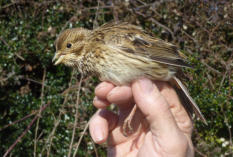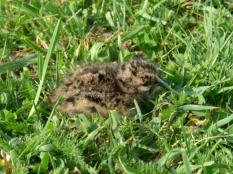





CONSERVATION SUCCESSES
LAPWING
These
birds
have
adopted
the
Stone
Culew
plot
-
perhaps
not
surprisingly
-
and
two
or
three
pairs
nest
each
year.
Fledging
success
is
questionable
in
most
years
due
to
pressures
from
crows
and
mammals
such
as
foxes
and
badgers
which
prey
on
ground
nesting
birds.
Though
2012
was
simply
washed
out.
However
some
years,
juvenile
birds
can
be
seen
nearby
post
fledging, indicating breeding success.
Lapwing displaying
Lapwing
made
a
reappearance
at
the
time
we
entered
Coutryside
Sewardship,
with
3
two
hectare
plots
of
bare
land
plus
the
Stone
Curlew
plot.
I
eventually
amalgamated
the
plots
into
one
and
this
together
with
the
growing
of
linseed
for
a
few
years
provided
bare
ground
in
the
spring
to
be
sufficiently
attractive
to
the
initial
failed
breeders
looking
for
a
new
site.
This
resulted
in
Lapwing
breeding
after
over
30
years
of
absence
in
the
arable
fields.
In
this
time
they have also made use of pea ground on ours and our neighbours land.
CORN BUNTING
Also
known
as
the
barley
bird,
this
bird
also
disappeared
from
its
arable
haunts,
though
this
time a little later, in the mid eighties.
The
stone
curlew
plot
is
now
adjacent
to
arable
reversal
grassland,
as
well
as
an
arable
field.
The
first
time
these
birds
tried
to
nest
was
after
the
second
of
the
two
reversal
patches
was
growing
in
its
first
season.
In
2012
there
were
two
possibly
three
pairs
in
this
downland
location,
as
well
as
a
male
singing
by
the
margin
of
a
lower
field
below.
Males
are
back
on
territory
early
in
the
year
and
can
be
heard
singing
from
February
onwards.
The
females
probably don’t join them until April


Corn Bunting singing













